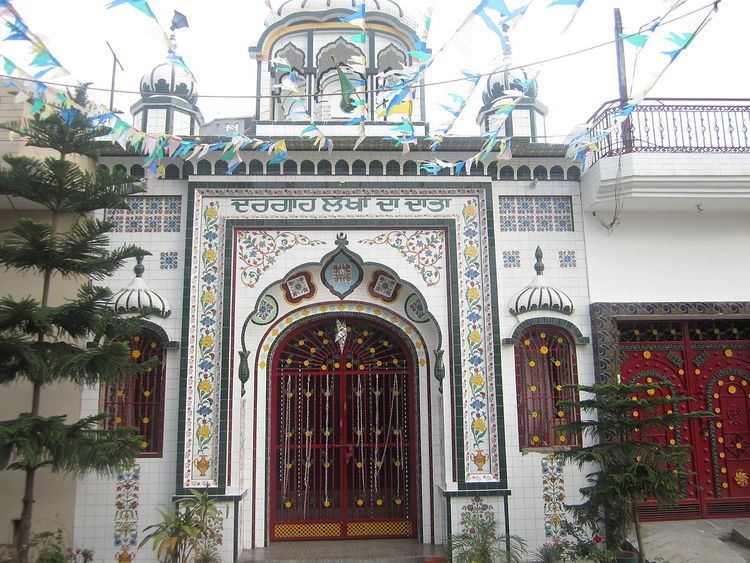 | ||
Died 1174, Dera Ghazi Khan District, Pakistan | ||
Hazrat Syed Ahmad Sultan, popularly known as Sakhi Sarwar, was a 12th-century Sufi saint of the Punjab region. He is also known by various other appellations such as Sultan (king), Lakhdata (bestower of millions), Lalanvala (master of rubies), Nigahia Pir (the saint of Nigaha) and Rohianvala (lord of the forests). His followers are known as Sultanias or Sarwarias.
Contents
Birth
Sakhi Sarwar was a son of Syed Sakhi Zain ul-Abideen, an immigrant from Medina who had settled at Shahkot, and Ayesha, a daughter of the village headman named Pira.
Life
When Sakhi Sarwar’s father died, his own relations maltreated him which resulted in him going to Baghdad where he was blessed with the gift of khilafat by three illustrious saints Ghauns-ul-Azm, Shaikh Shab-ud-Din Suhrawardi and Khwaja Maudud Chisti.
On his return to India, he first settled at dhaunkal, in Gujranwala district, and then at Shahkot. At Multan he married the daughter of a noble. In due course he became famous for his miraculous powers and soon had a considerable following.
This aroused the jealousy of his family who planned to kill him. Sakhi Sarwar got to know of their plans and escaped to Nigaha at the foot of the Sulaiman mountain, in Dera Ghazi Khan district, but his relatives pursued him there and ultimately murdered him in 1174. He was buried there and his followers built a shrine on the spot which subsequently became a place of pilgrimage for the devotees.
Nothing is known about the religious belief or teachings of Sultan Sakhi Sarwar. It was stories of his miracles and, especially, the protection he gave the animals that attracted many people to him.
Nigaha
The saint selected the town of Nigaha this place as his abode. It is known as the ‘last place’ because of the hostile geographical and climatic condition. According to Rose (1970), the buildings of the shrine consist of Sakhi Sarwar’s tomb on the west and a shrine associated with Guru Nanak Dev Ji on the north-west. On the east is an apartment containing the stool and spinning wheel of Mai Aeshan, Sakhi Sarwar’s mother. Near there is a Thakurdwara, and in another apartment is an image of Bhairon.
Within the enclosures of the shrine are the tombs of Sakhi Sarwar, his wife, known as Bibi Bai, and of the jinn (demon) whom he had held in his power and who brought many miracles for him.
Near the shrine at Nigaha there are two other holy spots called Chom and Moza, both associated with Murtaza, the son in law of Sakhi Sarwar. At Chom, an impression of the former`s hand was said to have been imprinted when he prevented a mountain from collapsing over the cave in which he had taken shelter.
To the west of the outhouses and within the shrine enclosure are two dead trees said to have sprung from the pegs which were used for the head and heel ropes of Kaki, the saint’s mare.
Other places
Shrines are situated at Dhaunkal in Wazirabad district, and also in Peshawar and Lahore.
There are numerous shrines in Indian Punjab where they are known as Nigaha. At some places Sakhi Sarwar is worshiped along with Gugga and their common shrines along with other deities are known as Panj Pirs or Nigahas.
The shrine of Baba Lakhdata at district Una in Himachal Pradesh is known as chotta (minor/small) Nigaha where a large fair is organised every year.
Worship
His followers who visit the Pir’s shrine at Nigaha are known as sang who refer to each other as bharais. The drumbeating bards who act as professional guides and priests at local shrines are called pirkhanas. Members of a sang address each other as pirbhaior and pirbahin (brother or sister in faith respectively).
Their halting points on the routes are known as chaukis (posts) where the pilgrims traditionally slept on the ground. Devotees unable to undertake the pilgrimage to Nigaha would attend at least one of the chaukis. If they could not, they went to any other village on the route for a night. Those who could not go anywhere at all slept on the ground at home for at least one night in a year.
This ritual of sleeping on the ground instead of on a cot is called chauki bharna.
Fairs
Various fairs are held in the Punjab region. The shrine at Nigaha holds a week-long Baisakhi fair in the month of April. Fairs are also held at Dhaunkal in Gujranwala district during June/July, at Jhanda Mela (fair of the flag) at Peshawar, and Qadamon ka Mela (fair of the feet) at Lahore.
A common ritual which is traditionally observed is to offer a raut, (a huge loaf prepared from 18 kilograms of wheat flour sweetened with jaggery weighing half that quantity) once a year on a Friday.
The raut is traditionally prepared by a Bharai, who took one fourth of the rotas offering, the remaining being consumed by the donor family and distributed among fellow Sultanias (followers of Sakhi Sarwar).
A famous fair known as "Chaunkian da Mela" is held in Mukandpur to commemorate Sakhi Sarwar's visit Balachaur, starting his journey from Rattewal and reaching Mukandpur where he stayed here for nine days. Since then this fair is held in Mukandpur and lasts for nine days. A "Saang" starts from Rattewal and reaches Mukandpur. The leader of the "Saang" holds a flag which is called a "Togh".
